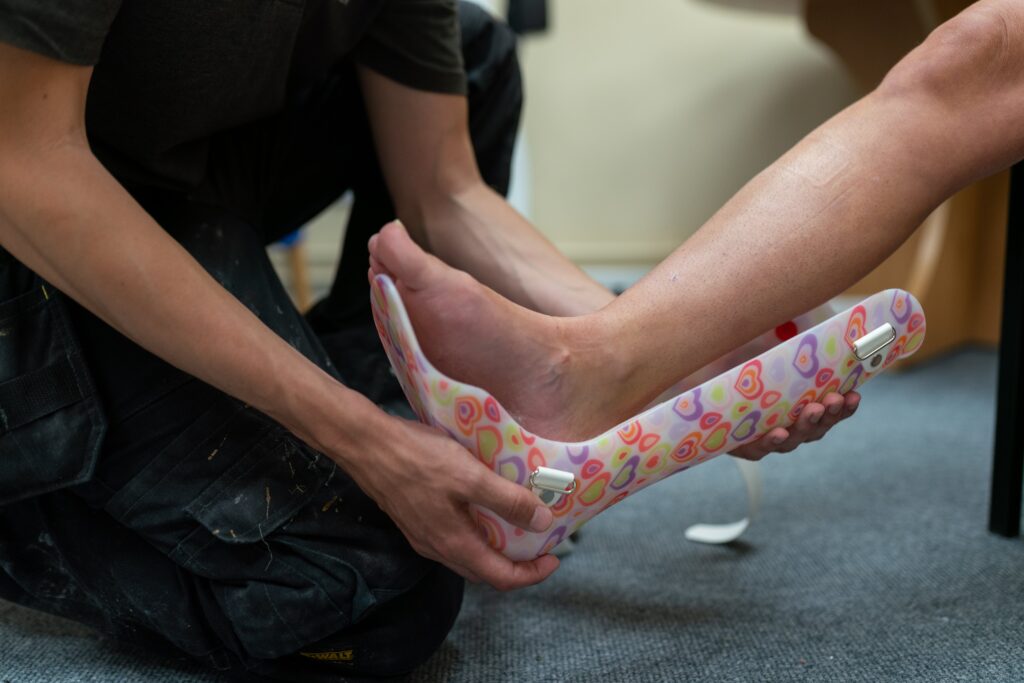
Your feet are the foundation of your body, supporting you in all that you do. Foot orthotics are customised shoe inserts that reduce pathological forces and improve foot function to help alleviate foot conditions.
Foot problems like high arches, flat feet, and poor alignment can cause excessive stress on the ankles and lower limbs. Orthotics can also be helpful in addressing bunions, neuromas, and plantar fasciitis.
Customisation
Customised orthotics are a device designed to provide support, cushioning, and alignment to the feet, ankles, and lower legs. They are commonly used to alleviate pain, reduce foot and heel spurs, correct structural abnormalities of the feet, increase balance and mobility. They are an excellent resource for patients who suffer from conditions such as plantar fasciitis, flat feet, heel spurs, and arthritis.
Orthotics are fabricated by using the latest 3D laser scan technology to accurately size, shape and design your individualised footwear. They are then digitally printed and directly milled in a variety of rigid or soft materials to suit your needs. Whether you want your orthotics coloured to match this season’s shoes or made with extra padding to help with pain in the ball of the foot (metatarsalgia) our team can cater to all your requirements.
The insoles are then heated to create the desired moulded shape of your orthotic. Once the insoles have been moulded they are placed into your shoes and allowed to cool. This process ensures that the insoles are securely fitted to your shoes, preventing them from shifting within the shoe or being pulled out during wear. During this time, any required adjustments to the insoles are made to improve comfort and function.
Biomechanical Assessment
Unlike over-the-counter inserts that are pre-fabricated, custom orthotics Adelaide are explicitly designed for your feet. This process starts with a consultation that looks at your range of motion, muscles, symmetry, and how you walk. This helps to ensure that the device is supporting your feet in the way that they need it most. They also help to distribute pressure evenly across the foot, reducing the risk of injury and enhancing overall function.
Whether you have a low or high arch, custom orthotics are an excellent tool for pain reduction and load redistribution. They can help with many common musculoskeletal injuries such as bursitis (the small fluid-filled sacs that can form around the joints in the feet) and neuromas (benign cysts between the 3rd and 4th toes). They can also reduce the incidence of recurring corns and calluses.
When your foot and ankle biomechanics are not functioning correctly, other parts of the body have to work harder to compensate. This can result in fatigue and an increased chance of injury. Correctly prescribed orthotics can control the forces acting on your feet and legs and allow them to function in a more natural way. The change in ground reaction forces can also help to prevent chronic overuse injuries. If you are using orthotics, it is important that they fit well in your shoes. Your podiatrist will be able to help you find shoe brands that are orthotic-friendly.
3D Laser Scan
Laser scanning is a highly advanced and non-destructive digital technology that uses lasers to measure the geometry of an object and craft it into a 3D model. This is accomplished by using software to capture data points that form a point cloud, which is a collection of coordinates, with each one representing a different measurement location in space (x standing for easting, y standing for nothing, and z standing for elevation).
3D scanning helps to reduce project timelines by enabling stakeholders to quickly gain access to near-real-time information about construction site conditions and dimensions. It also allows the rapid creation of prototypes, which can then be used to perform CAE and FEA engineering analysis.
Custom orthotics are specifically crafted to fit the unique shape of an individual’s feet and offer a more personalised and efficient solution for foot, ankle, and lower leg problems. They provide superior support, cushioning, and alignment, helping to alleviate pain and improve mobility.
The orthotics design is based on the podiatrist’s assessment, gait analysis, and 3D laser precision scan. The orthotics are then designed with the latest CAD cam software and directly milled from rigid or soft materials. The final orthotics are double-checked during a fitting appointment and then worn in the patients’ shoes for a few weeks to ensure they are comfortable and effective.
Fitting
Unlike over-the-counter (OTC) orthotics, which are mass-produced to fit a standard foot size and shape, custom orthotics are specifically designed to support and align your feet. They are made using accurate measurements and scans of your feet and provide superior cushioning, support, and alignment which leads to significant pain relief, improved mobility, and reduced foot and lower leg problems.
An Adelaide podiatrist is qualified to prescribe orthotic devices that are customised for the specific needs of your feet and legs. Correctly prescribed orthotics control forces acting upon the feet and legs reducing damaging forces, increasing gait efficiency, and eliminating fatigue which can lead to chronic overuse injuries such as heel pain.
Orthotics are used by athletes at all levels from amateur to professional elite levels, including many overuse sports injuries that can be helped with foot orthotic therapy. They provide enhanced support, stability, and shock absorption to reduce the risk of injury while providing optimal performance.
Our most popular custom orthotic is the TurboMed, a full-length slim-line orthotic that fits most shoes including running shoes. It is highly effective for runners and provides excellent arch support and relief from heel pain, ball of foot pain (metatarsalgia), Morton’s neuroma, and ‘hot feet’. It also works very well in most work boots, including steel-toe shoes. This device is also a very good solution for people with foot drop or weakness of the foot and ankle, which can affect many occupations including manual workers.